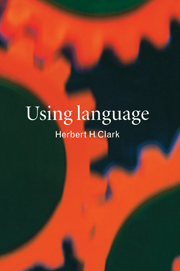1 - Language use
Published online by Cambridge University Press: 05 June 2012
Summary
Language is used for doing things. People use it in everyday conversation for transacting business, planning meals and vacations, debating politics, gossiping. Teachers use it for instructing students, preachers for preaching to parishioners, and comedians for amusing audiences. Lawyers, judges, juries, and witnesses use it in carrying out trials, diplomats in negotiating treaties, and actors in performing Shakespeare. Novelists, reporters, and scientists rely on the written word to entertain, inform, and persuade. All these are instances of language use – activities in which people do things with language. And language use is what this book is about.
The thesis of the book is this: Language use is really a form of joint action. A joint action is one that is carried out by an ensemble of people acting in coordination with each other. As simple examples, think of two people waltzing, paddling a canoe, playing a piano duet, or making love. When Fred Astaire and Ginger Rogers waltz, they each move around the ballroom in a special way. But waltzing is different from the sum of their individual actions – imagine Astaire and Rogers doing the same steps but in separate rooms or at separate times. Waltzing is the joint action that emerges as Astaire and Rogers do their individual steps in coordination, as a couple. Doing things with language is likewise different from the sum of a speaker speaking and a listener listening. It is the joint action that emerges when speakers and listeners – or writers and readers – perform their individual actions in coordination, as ensembles.
Information
- Type
- Chapter
- Information
- Using Language , pp. 3 - 26Publisher: Cambridge University PressPrint publication year: 1996
Accessibility standard: Unknown
Why this information is here
This section outlines the accessibility features of this content - including support for screen readers, full keyboard navigation and high-contrast display options. This may not be relevant for you.Accessibility Information
- 3
- Cited by
